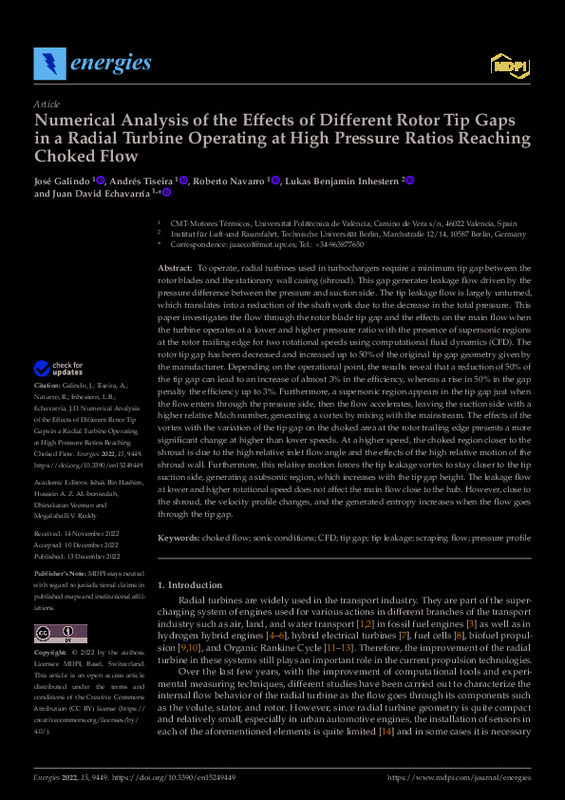JavaScript is disabled for your browser. Some features of this site may not work without it.
Buscar en RiuNet
Listar
Mi cuenta
Estadísticas
Ayuda RiuNet
Admin. UPV
Numerical Analysis of the Effects of Different Rotor Tip Gaps in a Radial Turbine Operating at High Pressure Ratios Reaching Choked Flow
Mostrar el registro sencillo del ítem
Ficheros en el ítem
| dc.contributor.author | Galindo, José
|
es_ES |
| dc.contributor.author | Tiseira, Andrés-Omar
|
es_ES |
| dc.contributor.author | Navarro, Roberto
|
es_ES |
| dc.contributor.author | Inhestern, Lukas Benjamin
|
es_ES |
| dc.contributor.author | Echavarria-Olaya, Juan David
|
es_ES |
| dc.date.accessioned | 2023-05-23T18:01:36Z | |
| dc.date.available | 2023-05-23T18:01:36Z | |
| dc.date.issued | 2022-12 | es_ES |
| dc.identifier.uri | http://hdl.handle.net/10251/193529 | |
| dc.description.abstract | [EN] To operate, radial turbines used in turbochargers require a minimum tip gap between the rotor blades and the stationary wall casing (shroud). This gap generates leakage flow driven by the pressure difference between the pressure and suction side. The tip leakage flow is largely unturned, which translates into a reduction of the shaft work due to the decrease in the total pressure. This paper investigates the flow through the rotor blade tip gap and the effects on the main flow when the turbine operates at a lower and higher pressure ratio with the presence of supersonic regions at the rotor trailing edge for two rotational speeds using computational fluid dynamics (CFD). The rotor tip gap has been decreased and increased up to 50% of the original tip gap geometry given by the manufacturer. Depending on the operational point, the results reveal that a reduction of 50% of the tip gap can lead to an increase of almost 3% in the efficiency, whereas a rise in 50% in the gap penalty the efficiency up to 3%. Furthermore, a supersonic region appears in the tip gap just when the flow enters through the pressure side, then the flow accelerates, leaving the suction side with a higher relative Mach number, generating a vortex by mixing with the mainstream. The effects of the vortex with the variation of the tip gap on the choked area at the rotor trailing edge presents a more significant change at higher than lower speeds. At a higher speed, the choked region closer to the shroud is due to the high relative inlet flow angle and the effects of the high relative motion of the shroud wall. Furthermore, this relative motion forces the tip leakage vortex to stay closer to the tip suction side, generating a subsonic region, which increases with the tip gap height. The leakage flow at lower and higher rotational speed does not affect the main flow close to the hub. However, close to the shroud, the velocity profile changes, and the generated entropy increases when the flow goes through the tip gap. | es_ES |
| dc.description.sponsorship | The work has been partially supported by the Subprograma de Formación de Profesorado Universitario (FPU). Ministerio de Universidades. FPU18/02628. | es_ES |
| dc.language | Inglés | es_ES |
| dc.publisher | MDPI AG | es_ES |
| dc.relation.ispartof | Energies | es_ES |
| dc.rights | Reconocimiento (by) | es_ES |
| dc.subject | Choked flow | es_ES |
| dc.subject | Sonic conditions | es_ES |
| dc.subject | CFD | es_ES |
| dc.subject | Tip gap | es_ES |
| dc.subject | Tip leakage | es_ES |
| dc.subject | Scraping flow | es_ES |
| dc.subject | Pressure profile | es_ES |
| dc.subject.classification | INGENIERIA AEROESPACIAL | es_ES |
| dc.subject.classification | MAQUINAS Y MOTORES TERMICOS | es_ES |
| dc.title | Numerical Analysis of the Effects of Different Rotor Tip Gaps in a Radial Turbine Operating at High Pressure Ratios Reaching Choked Flow | es_ES |
| dc.type | Artículo | es_ES |
| dc.identifier.doi | 10.3390/en15249449 | es_ES |
| dc.relation.projectID | info:eu-repo/grantAgreement/MIU//FPU18%2F02628/ | es_ES |
| dc.rights.accessRights | Abierto | es_ES |
| dc.contributor.affiliation | Universitat Politècnica de València. Escuela Técnica Superior de Ingeniería del Diseño - Escola Tècnica Superior d'Enginyeria del Disseny | es_ES |
| dc.description.bibliographicCitation | Galindo, J.; Tiseira, A.; Navarro, R.; Inhestern, LB.; Echavarria-Olaya, JD. (2022). Numerical Analysis of the Effects of Different Rotor Tip Gaps in a Radial Turbine Operating at High Pressure Ratios Reaching Choked Flow. Energies. 15(24):1-30. https://doi.org/10.3390/en15249449 | es_ES |
| dc.description.accrualMethod | S | es_ES |
| dc.relation.publisherversion | https://doi.org/10.3390/en15249449 | es_ES |
| dc.description.upvformatpinicio | 1 | es_ES |
| dc.description.upvformatpfin | 30 | es_ES |
| dc.type.version | info:eu-repo/semantics/publishedVersion | es_ES |
| dc.description.volume | 15 | es_ES |
| dc.description.issue | 24 | es_ES |
| dc.identifier.eissn | 1996-1073 | es_ES |
| dc.relation.pasarela | S\481705 | es_ES |
| dc.contributor.funder | Ministerio de Universidades | es_ES |








